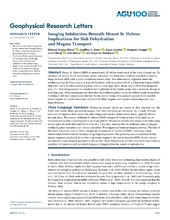Imaging Subduction Beneath Mount St. Helens: Implications for Slab Dehydration and Magma Transport
Mann, Michael E.; Abers, Geoffrey A.; Crosbie, Kayla; Creager, Kenneth; Ulberg, Carl; Moran, Seth; Rondenay, Stéphane
Peer reviewed, Journal article
Published version

Åpne
Permanent lenke
https://hdl.handle.net/1956/23302Utgivelsesdato
2019Metadata
Vis full innførselSamlinger
- Department of Earth Science [1050]
Originalversjon
https://doi.org/10.1029/2018gl081471Sammendrag
Mount St. Helens (MSH) is anomalously 35–50 km trenchward of the main Cascade arc. To elucidate the source of this anomalous forearc volcanism, the teleseismic‐scattered wavefield is used to image beneath MSH with a dense broadband seismic array. Two‐dimensional migration shows the subducting Juan de Fuca crust to at least 80‐km depth, with its surface only 68 ± 2 km deep beneath MSH. Migration and three‐dimensional stacking reveal a clear upper‐plate Moho east of MSH that disappears west of it. This disappearance is a result of both hydration of the mantle wedge and a westward change in overlying crust. Migration images also show that the subducting plate continues without break along strike. Combined with low temperatures inferred for the mantle wedge, this geometry greatly limits possible source regions for mantle melts that contribute to MSH magmas and requires lateral migration over large distances.